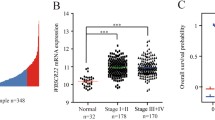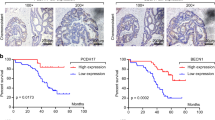Abstract
Purpose
Loss of P53 binding protein 1 (53BP1) is considered a poor prognostic factor for colorectal cancer. However, its effect on chemosensitivity of colorectal cancer to 5-fluorouracil (5-FU) remains elusive. This study aimed to examine the association of 53BP1 expression with chemosensitivity of colorectal cancer cells to 5-FU.
Methods
Immunohistochemistry was performed on 30 metastatic colorectal cancer samples to assess the associations of 53BP1 levels with clinical therapeutic effects. In vitro, IC50 values for 5-FU and 53BP1 levels were determined by MTT assay and Western blot in 5 colorectal cancer cell lines. Then, 53BP1 was silenced in HCT116 and HT29 cells, and cell proliferation, apoptosis and cell cycle distribution were evaluated. Relative protein levels of ATM–CHK2–P53 pathway effectors and Bcl-2 family members were measured by Western blot. Finally, the effects of 53BP1 knockdown on tumor growth and 5-FU chemoresistance were investigated in vivo.
Results
53BP1 expression was closely related to time to progression (TTP) after first-line chemotherapy. Namely, 53BP1 downregulation resulted in reduced TTP. In addition, 53BP1 silencing increased proliferation, inhibited apoptosis and induced S phase arrest in HCT116 and HT29 cells after 5-FU treatment. Moreover, 53BP1 knockdown also reduced the protein levels of ATM–CHK2–P53 apoptotic pathway effectors, caspase9 and caspase3, while increasing Bcl-2 expression. In vivo, 53BP1 silencing accelerated tumor proliferation in nude mice and enhanced resistance to 5-FU.
Conclusions
These findings confirmed that 53BP1 loss might be a negative factor for chemotherapy efficacy, promoting cell proliferation and inhibiting apoptosis by suppressing ATM–CHK2–P53 signaling, and finally inducing 5-FU resistance.







Similar content being viewed by others
References
Adam R, Haller DG, Poston G et al (2010) Toward optimized front-line therapeutic strategies in patients with metastatic colorectal cancer: an expert review from the International Congress on Anti-Cancer Treatment (ICACT) 2009. Ann Oncol 21:1579–1584
Alfarouk KO, Stock CM, Taylor S et al (2015) Resistance to cancer chemotherapy: failure in drug response from ADME to P-gp. Cancer Cell Int 15:71
Ausborn NL, Wang T, Wentz SC et al (2013) 53BP1 expression is a modifier of the prognostic value of lymph node ratio and CA 19–9 in pancreatic adenocarcinoma. BMC Cancer 13:155
Bartkova J, Guldberg P, Gronbaek K et al (2004) Aberrations of the Chk2 tumour suppressor in advanced urinary bladder cancer. Oncogene 23:8545–8551
Bartkova J, Horejsi Z, Sehested M et al (2007) DNA damage response mediators MDC1 and 53BP1: constitutive activation and aberrant loss in breast and lung cancer, but not in testicular germ cell tumours. Oncogene 26:7414–7422
Bi J, Huang A, Liu T, Zhang T, Ma H (2015) Expression of DNA damage checkpoint 53BP1 is correlated with prognosis, cell proliferation and apoptosis in colorectal cancer. Int J Clin Exp Pathol 8:6070–6082
Bohgaki M, Bohgaki T, El Ghamrasni S et al (2013) RNF168 ubiquitylates 53BP1 and controls its response to DNA double-strand breaks. Proc Natl Acad Sci USA 110:20982–20987
Bouwman P, Aly A, Escandell JM et al (2010) 53BP1 loss rescues BRCA1 deficiency and is associated with triple-negative and BRCA-mutated breast cancers. Nat Struct Mol Biol 17:688–695
Carr SM, Munro S, Zalmas LP et al (2014) Lysine methylation-dependent binding of 53BP1 to the pRb tumor suppressor. Proc Natl Acad Sci USA 111:11341–11346
Chiu YT, Liu J, Tang K, Wong YC, Khanna KK, Ling MT (2012) Inactivation of ATM/ATR DNA damage checkpoint promotes androgen induced chromosomal instability in prostate epithelial cells. PLoS ONE 7:e51108
Clarke AR, Jones N, Pryde F, Adachi Y, Sansom OJ (2007) 53BP1 deficiency in intestinal enterocytes does not alter the immediate response to ionizing radiation, but leads to increased nuclear area consistent with polyploidy. Oncogene 26:6349–6355
Folprecht G, Gruenberger T, Bechstein WO et al (2010) Tumour response and secondary resectability of colorectal liver metastases following neoadjuvant chemotherapy with cetuximab: the CELIM randomised phase 2 trial. Lancet Oncol 11:38–47
Haffty BG, Goyal S, Kulkarni D et al (2011) Evaluation of single nucleotide polymorphisms (SNPs) in the p53 binding protein 1 (TP53BP1) gene in breast cancer patients treated with breast-conserving surgery and whole-breast irradiation (BCS + RT). Int J Radiat Oncol Biol Phys 80:385–391
Hu JL, Liu LP, Yang SL et al (2016) Hepatitis B virus induces hypoxia-inducible factor-2α expression through hepatitis B virus X protein. Oncol Rep 35:1443–1448
Iwabuchi K, Bartel PL, Li B, Marraccino R, Fields S (1994) Two cellular proteins that bind to wild-type but not mutant p53. Proc Natl Acad Sci USA 91:6098–6102
Jemal A, Bray F, Center MM, Ferlay J, Ward E, Forman D (2011) Global cancer statistics. CA Cancer J Clin 61:69–90
Knappskog S, Chrisanthar R, Lokkevik E et al (2012) Low expression levels of ATM may substitute for CHEK2/TP53 mutations predicting resistance towards anthracycline and mitomycin chemotherapy in breast cancer. Breast Cancer Res 14:R47
Lai TC, Chow KC, Lin TY et al (2010) Expression of 53BP1 as a cisplatin-resistant marker in patients with lung adenocarcinomas. Oncol Rep 24:321–328
Li X, Xu B, Moran MS et al (2012) 53BP1 functions as a tumor suppressor in breast cancer via the inhibition of NF-κB through miR-146a. Carcinogenesis 33:2593–2600
Ma H, Bi J, Liu T, Ke Y, Zhang S, Zhang T (2015) Icotinib hydrochloride enhances the effect of radiotherapy by affecting DNA repair in colorectal cancer cells. Oncol Rep 33:1161–1170
Malvezzi M, Arfe A, Bertuccio P, Levi F, La Vecchia C, Negri E (2011) European cancer mortality predictions for the year 2011. Ann Oncol 22:947–956
Morales JC, Franco S, Murphy MM et al (2006) 53BP1 and p53 synergize to suppress genomic instability and lymphomagenesis. Proc Natl Acad Sci USA 103:3310–3315
Neboori HJ, Haffty BG, Wu H et al (2012) Low p53 binding protein 1 (53BP1) expression is associated with increased local recurrence in breast cancer patients treated with breast-conserving surgery and radiotherapy. Int J Radiat Oncol Biol Phys 83:e677–e683
Nuciforo PG, Luise C, Capra M, Pelosi G, d’Adda di Fagagna F (2007) Complex engagement of DNA damage response pathways in human cancer and in lung tumor progression. Carcinogenesis 28:2082–2088
O’Connell JB, Maggard MA, Ko CY (2004) Colon cancer survival rates with the new American Joint Committee on Cancer sixth edition staging. J Natl Cancer Inst 96:1420–1425
Pan S, Cheng L, White JT et al (2009) Quantitative proteomics analysis integrated with microarray data reveals that extracellular matrix proteins, catenins, and p53 binding protein 1 are important for chemotherapy response in ovarian cancers. OMICS 13:345–354
Panier S, Durocher D (2013) Push back to respond better: regulatory inhibition of the DNA double-strand break response. Nat Rev Mol Cell Biol 14:661–672
Rybanska-Spaeder I, Reynolds TL, Chou J et al (2013) 53BP1 is limiting for NHEJ repair in ATM-deficient model systems that are subjected to oncogenic stress or radiation. Mol Cancer Res 11:1223–1234
Santarosa M, Maestro R (2012) BRACking news on triple-negative/basal-like breast cancers: how BRCA1 deficiency may result in the development of a selective tumor subtype. Cancer Metastasis Rev 31:131–142
Shi Y, Felley-Bosco E, Marti TM, Orlowski K, Pruschy M, Stahel RA (2012) Starvation-induced activation of ATM/Chk2/p53 signaling sensitizes cancer cells to cisplatin. BMC Cancer 12:571
Squatrito M, Brennan CW, Helmy K, Huse JT, Petrini JH, Holland EC (2010) Loss of ATM/Chk2/p53 pathway components accelerates tumor development and contributes to radiation resistance in gliomas. Cancer Cell 18:619–629
Sun CC, Chiu HT, Lin YF, Lee KY, Pang JH (2015) Y-27632, a ROCK Inhibitor, promoted limbal epithelial cell proliferation and corneal wound healing. PLoS ONE 10:e0144571
Tanaka K, Saigusa S, Toiyama Y et al (2012) TS and DPD mRNA levels on formalin-fixed paraffin-embedded specimens as predictors for distant recurrence of rectal cancer treated with preoperative chemoradiotherapy. J Surg Oncol 105:529–534
Tanos R, Karmali D, Nalluri S, Goldsmith KC (2015) Select Bcl-2 antagonism restores chemotherapy sensitivity in high-risk neuroblastoma. BMC Cancer 16:97
Ward IM, Difilippantonio S, Minn K et al (2005) 53BP1 cooperates with p53 and functions as a haploinsufficient tumor suppressor in mice. Mol Cell Biol 25:10079–10086
Author information
Authors and Affiliations
Corresponding author
Ethics declarations
Conflict of interest
All authors declare that they have no conflict of interests.
Ethical approval
This study was approved by the Human Ethics Review Board of the Union Hospital of Tongji Medical College, Huazhong University of Science and Technology (Hubei, China).
Informed consent
Informed consent was obtained from all individual participants included in the study.
Additional information
Jing Yao and Ai Huang have contributed equally to this work.
Rights and permissions
About this article
Cite this article
Yao, J., Huang, A., Zheng, X. et al. 53BP1 loss induces chemoresistance of colorectal cancer cells to 5-fluorouracil by inhibiting the ATM–CHK2–P53 pathway. J Cancer Res Clin Oncol 143, 419–431 (2017). https://doi.org/10.1007/s00432-016-2302-5
Received:
Accepted:
Published:
Issue Date:
DOI: https://doi.org/10.1007/s00432-016-2302-5




